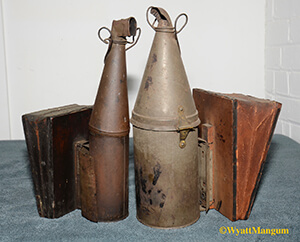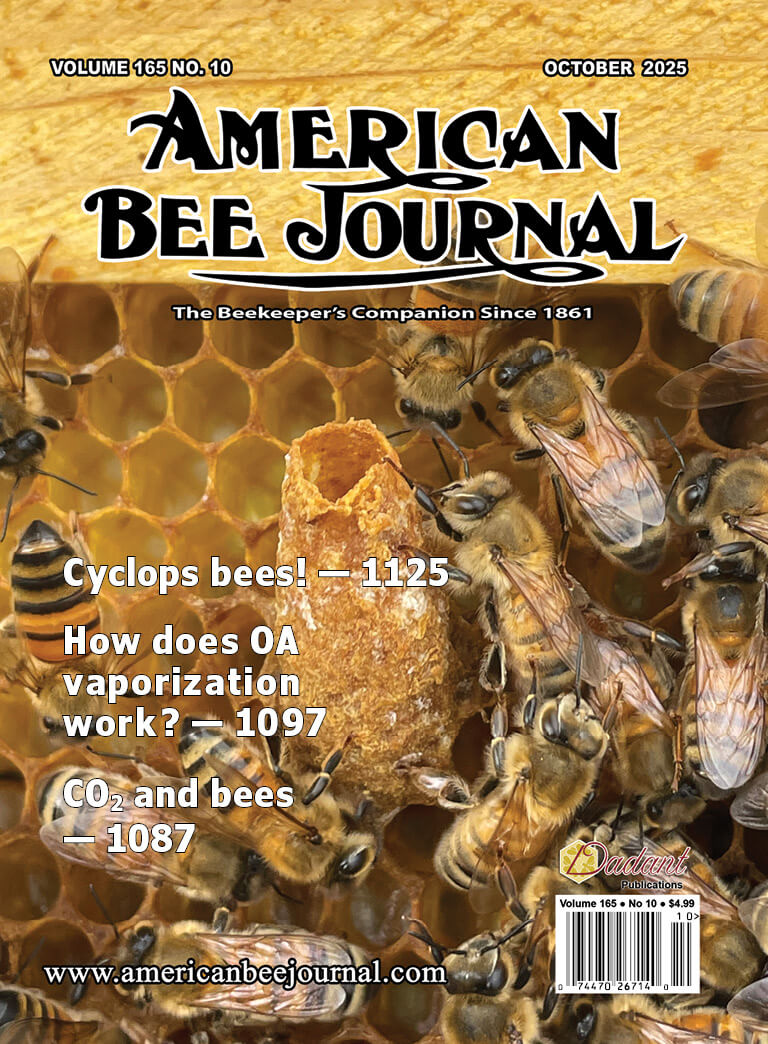
Once long ago, before the standard bee smoker became so iconic, smudge pots or other creative contraptions were supposed to waft smoke over irritable bees after opening the hive. More often the beekeeper disappeared within an eye-blinding cloud of smoke. Corncobs aplenty littered the old country farms of the 1800s. Many a beekeeper-farmer made use of a cob’s smoldering properties trying to subdue their bees, powered by human breath until overcome by dizziness and nausea.
The pivotal year in the development of the bee smoker occurred in 1873, when Moses Quinby of St. Johnsville, New York produced a practical bellows smoker.1 His smoker began to resemble the modern form, though the funnel pointed straight up (see Figure 1). Quinby’s lightweight smoker could be operated with one hand, the funnel directing smoke right to where it was needed. Yet among Quinby’s earliest smokers, the fire went out prematurely. Quinby may have corrected this flaw, but in May of 1875, he died suddenly. Nevertheless, Quinby purposefully did not patent his crucial invention. Instead, he gave his bee smoker invention freely to the beekeeping community.
Other beekeeper-inventors made improvements on Quinby’s breakthrough design. The long lineage we will follow is an early one, from Tracy F. Bingham of Abronia, Michigan. Bingham was a clever inventor, and a master at marketing smokers too. A patent issued to him in 1878 marked the beginning of a smoker allowing a passive airflow to maintain the fire so it would not go out and leave the beekeeper unprotected. Interestingly, back then no patent classification existed for a “bee smoker.” Ironically, the patent office classified Bingham’s bee smoker as a “Device for Destroying Insects by Fumigation.”
Instead of a solid connecting pipe between the firebox and bellows, as in the original Quinby design, Bingham left a small, but critical, open gap between them. This arrangement allowed air to draft upward from the bottom of the firebox, through the fire, and out from the funnel when the bellows were not pumped. In the patent, Bingham explained,
It will be observed that an open space is left between … the bellows and the … opening of the stove [firebox]; the object of which is … to allow the air to pass freely to both the stove and the bellows, and at the same time to enable the air to be forced into the stove to project the smoke in the direction desired.
On your modern smoker, that humble but decisive gap remains, a silent testimony to Bingham’s lasting innovation (see Figure 2). The Bingham innovation story is far from complete.
Notice refueling a hot smoker with a simple straight-up cone-style funnel would be awkward. Finger burns would be common on the hot metal. Bingham wanted his smokers refueled without that danger. His 1892 patent announced the solution, a wire handle. Although the smoker gets hot, the slender wire efficiently radiates heat and remains cool. The wire loops on the earlier funnels tended to be elaborate. Later on, the loops became simpler, easier to mass-produce with less material (see Figures 3 and 4). Today it’s hard to imagine how we could get along without the coil wire handle on the top of our smoker, letting us quickly refuel it burn-free. (If those wire coils on a modern smoker become hot, you are running the smoker way too hot. The smoldering fire needs to be smaller with more unburned fuel on top of it.)
Another of Bingham’s smoker designs really baffled me for a few years, mainly because it did not stand the test of time. It started in earnest when I acquired a Bingham smoker in mint condition, still factory shiny inside, never touched by a fire’s black soot. The smoker though was built in a weird way. The funnel fit on the inside of the cylindrical barrel forming the firebox (see Figure 5). Usually the funnel fits on the outside like the modern version. I thought perhaps this feature might be a defect, thus accounting for the lack of use. However, the cylindrical barrel was rolled with an inward projecting rim just below the upper rim, where the funnel fit into it. This internal rim stopped the funnel from going too deep where it could not be removed. It seemed then all this construction was done for some purpose, a reason buried in the past. Why?
Bingham’s 1903 patent provided the answer and was reminiscent of an annoying problem we still see today. With repeated use, soot and tar accumulate in a smoker. Black tar condenses in the funnel (because it’s cooler) and runs downward. If the cap fits on the outside of the rim, the tar leaks out and runs down the outside of the smoker. These tar streaks are commonly seen on the outside of modern smokers.
Bingham wanted a smoker without these tar streaks. Furthermore, he wanted to prevent the smoker from blowing bits of condensed tar and ash onto newly built white comb-honey sections, where their removal was exceedingly difficult. His solution: Make the funnel fit on the inside of the rim, forcing the tar to run down the inside, into the fire, where it would be burned again. Hence advertisements sometimes called these smokers soot-burning or self-cleaning smokers.
The funnel on the original Bingham, like the Quinby before it, pointed straight up. To use either, the smoker must be inverted, pointing the funnel downward to direct the smoke on the bees. This position created an annoying problem. Burning embers could fall on the bees and get between the frames, a condition sometimes called “fire dropping” in the old bee literature. Bingham’s simple solution was to deflect the smoke to the side with a small piece of metal attached around the opening of the funnel (see Figure 4 again, the left smoker). This improvement avoided having to redesign the shape of the funnel. With the deflector, the smoker could be used upright, making it easier to handle. In later production, the smoke deflector was simplified to just a curved piece of metal (see Figure 4 again, the right smoker and Figure 5, both deflectors).
Having innovative ideas is only part of surviving in the bee supply trade, beset with intense competition and copycats. To keep selling smokers through the years, one had to be innovative at marketing too. One competitive advantage was to offer smokers in different sizes, letting beekeepers choose the one best suiting their needs. At first Bingham gave his smokers rather dull, drab, amorphous names like “extra-large” and “plain.” Later the names changed. The new names were a stroke of marketing flair. They showed an empathy with a stung-up beekeeper, enduring with defensive hybrid bees of the time and little means to control them.
In 1885, a Bingham advertisement caught the reader’s eye with a smoker named “THE CONQUEROR,” emblazoned across the page, boldly in banner headline style, as if some glorious battle had ended in a victory, this time for the beekeeper. Another Bingham smoker carried a less audacious name, the “Doctor,” a name suggesting authority and a certain amount of corrective medicine for irritable bees.
The Conqueror and Doctor were fairly large smokers with barrel diameters (the fireboxes) of three inches, and three and a half inches, respectively. Later came an even larger smoker size, by their old standards, a whopping four-inch diameter barrel. It was aptly named the “Smoke Engine.” For beekeepers in the late 1800s, that name easily conjured up images of a giant rugged railroad steam engine belching out huge columns of dark smoke into the sky, a mighty source of strength, power, and awe. What a perfect image for a bee smoker in the growing railroad culture of the time.
At the opposite end of the size spectrum was a small petite smoker, at only a one-and-three-quarter-inch diameter barrel. It carried the do-not-underestimate-me name of “Little Wonder.” In later years, its size slowly …


